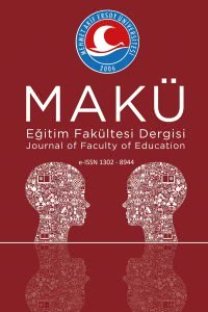Değişken Kavramının Öğretimi: Harf Sembollerin Farklı Kullanımları
Değişken kavramı, matematik müfredatının tamamını etkileyen önemli bir kavramdır. Değişken kavramının anlaşılması, cebirin ve ileri matematiksel kavramların öğrenilebilmesi için zorunludur. Ancak, her düzeydeki öğrencilerin değişken kavramını anlamakta sıkıntısının olduğu görülmektedir. Bu sıkıntılar, bir çok faktörden kaynaklanabilir. Ancak, bu faktörlerden birisi belki de en önemlisi, değişken kavramının gösteriminde kullanılan harf sembollerin, farklı kullanımlarından kaynaklanmaktadır. Bu çalışmada, harf sembollerin farklı kullanımlarının belirlenmesi ve bu farklı kullanımlarından kaynaklanan karışıklıkların bir nebze de olsa giderilmesi amaçlanmıştır. Bu nedenle, Gazi Üniversitesi Gazi Eğitim Fakültesi OFMAE Bölümü, Matematik Eğitimi ABD’nın son sınıfında okuyan 35 öğrenciye bir etkinlik uygulanmıştır. Bu etkinlikte, önce öğrencilerin harf sembollerin farklı kullanımlarına yönelik bilgi düzeylerini belirlemek üzere 12 sorudan oluşan bir çalışma kağıdı (worksheet) her bir öğrenciye dağıtılmış ve cevaplanması için 30 dakikalık süre verilmiştir. Daha sonra da, öğrencilerin her bir soruya ilişkin görüşlerini daha ayrıntılı olarak alabilmek ve harf sembollerin farklı kullanımlarının daha iyi anlaşılabilmesini sağlamak için sınıfta bir tartışma ortamı oluşturulmuştur. Öğrencilerin çalışma kağıtlarındaki cevapları ve sınıfta her bir soruya yönelik yapılan tartışmalar, matematik öğretmeni adayı olan bu öğrencilerin harf sembollerin farklı kullanımları hakkında yetersiz ve eksik bilgiye sahip olduklarını göstermiştir.
The Teaching of the Concept of Variable: The Different Uses of Literal Symbols
The concept of variable is one of the most important concepts that have a significant effect on whole mathematics curriculum. Understanding of this concept is necessary for the learning of algebra and advanced mathematics concepts. However, students who are in different level of understandings have showed the troubles on the concept of variable. These troubles could be caused by many factors. But, one of these factors, probably the most important one, is the different ways of using the concept of variable in the representation of literal symbols. The purpose of the present study is to identify the different uses of literals symbols and be able to overcome difficulties that occur in the use of different literal symbols. Subjects of the study were a total of 35 senior student-teachers in the Department of Mathematics Education, OFMAE main branch, at Gazi university. During the study, a worksheet including 12 questions were administered to the students to assess the level of their understanding of the different use of literal symbols. The 30 minutes were given the students to complete the worksheet. After that, a discussion-meeting was hold with the students to get more specific and detail information about the answers to the each question and help them to better understand about the concept of the different use of literal symbols. Findings from examinations of the worksheets and the whole class-discussion showed that these senior student-teachers were an inadequate and lacking in using different litteral symbols in the concept of variable.
___
Carpenter, T.; Stafslien, C.; Thiem, N.; ve Weinberg, A. (2001). “Curriculum & Instruction 811”. www.math.wisc.edu/~weinberg/MathEd/Algebra_Final_ Paper. docDede, Y. (2003). “Öğe Gösterim Teorisi (Component Display Theory) ve ARCS Motivasyon Modeli’ne Dayalı Yaklaşımın Öğrencilerin Değişken Kavramını Öğrenme Düzeylerine ve Motivasyonlarına Etkisi” Yayınlanmamış Doktora Tezi, Gazi Üniversitesi Eğitim Bilimleri Enstitüsü, Ankara.
Kuchemann, D. (1978). “Children’s Understanding Of Numerical Variable”. Mathematics in School. 7(4), s.23-28.
Kuchemann, D. (1981). Algebra. Children’s Understanding Mathematics: 11- 16. (Ed. K.M. Hart). London. s. 102 - 119.
Macgregor, M.ve Stacey, K. (1997a). “Students’ Understanding Of Algebraic Notation : 11-15”. Educational Studies in Mathematics 33: s.1-19.
Macgregor, M.ve Stacey, K. (1997b). “Ideas About Symbolism That Students Bring To Algebra”. The Mathematics Teacher. February, vol 90, No. 2, s.110-113.
Philipp, R. (1992a). “A Study of Algebraic Variables:Beyond the Student - Professor Problem”. Journal of Mathematical Behavior 11. s.161-176.
Philipp, R. (1992b). “The Many Uses Of Algebraic Variables”. The Mathematics Teacher. October, vol 85, No.7, s. 557-561.
Schoenfeld, A. ve Arcavi, A. (1988). “On The Meaning of Variable”. Mathematics Teacher. September, s. 420-427.
Ursini, S. ve Trigerous, M. (2001). “A Model For the Uses of Variable In Elementary Algebra”. In Van den Heuvel-Panhuizen M. (Ed.), Proceedings of the XXV PME International Conference. Utrecht, Neatherlands, vol. 4, pp. 327-334.
Wagner, S. (1981). An Analytical Framework for Mathematical Variables, In Proceedings Of The Fift Conference By Of The Psychology Of Mathematics Education, Edited By C. Comti And G. Vernaud, s. 165 - 170. Grenoble, France.
Wagner, S. (1983). “What Are These Things Called Variables?”. Mathematics Teacher, October, s. 474 - 478.
Warren, E. ve English L. (1998). “Introducing the Variable Through Pattern Exploration”. The Mathematics Teacher. February, vol 91, No. 2, s.166- 170.
- ISSN: 1302-8944.
- Yayın Aralığı: Yılda 2 Sayı
- Başlangıç: 2018
Sayıdaki Diğer Makaleler
Eğitim Planlamasında Coğrafi Bilgi Sistemlerinden Yararlanma
Eğridir Gölü Güneyinde Fonksiyon Değiştiren Yerleştirmelere Bir Örnek: Kelifler
Parça Yazı ve Yolculuk Anlatısı
Değişken Kavramının Öğretimi: Harf Sembollerin Farklı Kullanımları
Seramik Sanatı ve Eğitimi Üzerine Değerlendirmeler
